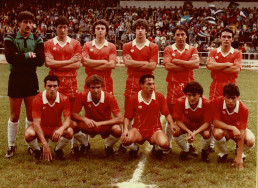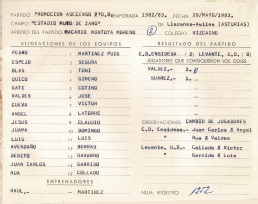Levante’s starting eleven for the first leg of the Segunda B promotion playoff against Ensidesa in Avilés. Top; Martínez Puig, Cotino, Segura, Gimeno, José and Toni. Below; Victor, Latorre, Luis, Domingo and Claudio.
The image dates back to the first half of the 1980s. The action takes place in Asturias. The Muro de Zaro Stadium hosts Levante. The Blue and Whites have travelled the whole of the Iberian Peninsula by bus to face the start of the Second Division B promotion play-offs. The 1982-1983 season moves towards its conclusion. Ensidesa challenged the hosts prepared by Pepe Martínez in a two-legged tie. Avilés was the first stop. The winner of this double-header will not feel the intoxicating sensation of promotion. Returning to the Bronze Division meant overcoming a major challenge in the form of two knockout rounds in a row. Four ruthless encounters to return to the lost threshold.
It may be difficult to recognise the Levante silhouette in a match with a Dantesque sign. In this case, the absence of the usual badge becomes an added difficulty. The blue and reds came out to the Avilés stadium in a rigorous orange kit. It’s not a colour that is associated with the historic azulgrana imaginary, but in those days it was a recurring colour. In that line-up, the presence of Latorre stands out. He is second from the left in the bottom row. He is included between Víctor Santamaría and Luis. The image is part of his most intimate memories and belongings. The photograph commemorates a historic match and is in one of his personal albums, which records his long stay in the Orriols neighbourhood.
That match ended with a home win (2-0). The match travelled to what is now the Ciutat de València. Latorre scored the home side’s goal, but the victory was not enough to turn the tie around. Those were dark days. That Levante team was wandering around Group VI of the Third Division after feeling the sting of two relegations in a row at the end of the 1981-1982 season. From the structures of professional football to the hell of a more amateur football. From Segunda A to Segunda B due to sporting demerits and from the Bronze category to Tercera due to non-payments in a desolate summer marked by World Cup 82 played in Spain. Destiny seemed bleak and the horizon threatened to engulf a Levante team that was trying to find solutions to escape from economic, sporting and also social ruin.
Record of the match between Levante and Ensidesa in Asturias at the end of May 1983.
In this context, we must include the proposal presented by Antonio Aragonés in May 1982 at the General Assembly. He proposed the creation of a new club called Naranja CF. He intended to involve the orange sector in the purchase of shares worth 100,000 pesetas each. The founding members would have free access to all Naranja matches for a period of ten years. The nascent entity would have as its identifying banner a shield formed by an orange embraced by a Lo Rat Penat and in the chosen kit, for obvious reasons, the colour orange would stand out.
With regard to Levante, his idea of regeneration included relegating them to the Third Division. Levante would play their official matches at the Nou Estadi, although the intention was to build another facility with a capacity for between five and eight thousand spectators in an area within the maritime area. Levante’s management would be independent of the Orange, although there would be a cordial entente with permanent collaboration agreements and with the full support of the Orange from an economic, technical and field perspective. Needless to say, this project did not prosper. The opposition of the Granotas’ members was as unanimous as it was generalised.
There was tension and hostility to the programme outlined by Antonio Aragonés, but perhaps the choice of orange as an alternative kit to the traditional colours was part of this projection. In principle, they would continue to play their matches at the Nou Estadi, although the intention was to build another facility with a capacity for five and eight thousand spectators in an area within the maritime area. Levante’s management would be independent of the Naranja, although there would be a cordial entente with permanent collaboration agreements and with the total support of the Naranja from an economic, technical and on-field point of view during the 1982-1983 and 1983-1984 seasons.

